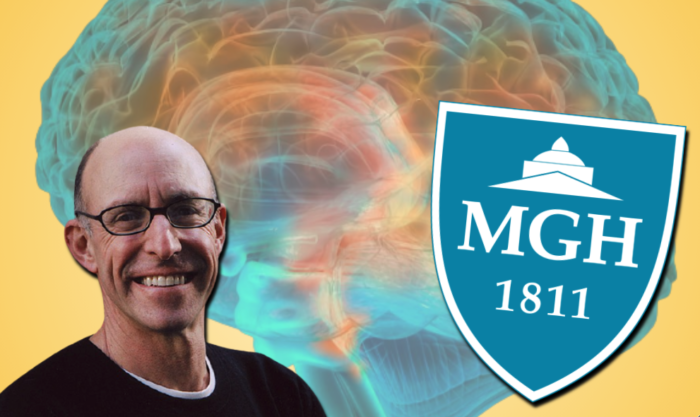
“We have the mindset and the intention to make a huge difference to patients around the world—and we have the tools and talent to make that possible.”
MGH’s Center for the Neuroscience of Psychedelics celebrated its official March 9 launch with a webinar headlined by renowned science writer Michael Pollan.
A professor of journalism at UC Berkeley and of nonfiction at Harvard, Pollan is heralded as a hero within the psychedelics research and advocacy communities for his 2018 smash hit, How to Change Your Mind: What the New Science of Psychedelics Teaches Us About Consciousness, Dying, Addiction, Depression, and Transcendence.
“What journalists are good at is maybe seeing around one corner,” Pollan said. “We’re not visionaries, but we do have our fingers in the air. And when the zeitgeist is kind of shifting, we often pick up on it a little bit early. And I had some sense that there was something in the air with psychedelics before I published the book.”
This New York Times bestselling author is again sensing something in the air: indeed, he deemed the MGH center “one of the most encouraging developments” for the field of psychedelics in the last few years.
The center is the brainchild of Jerrold “Jerry” Rosenbaum, a psychiatry professor at Harvard Medical School and the psychiatrist-in-chief emeritus at MGH.
“Like so many of you, we came to be hopeful and were struck by the promise of psychedelic agents to really potentially be game changers for the future of psychiatric and—more broadly—brain health,” Rosenbaum said, addressing the webinar’s 1,200-plus registrants. Indeed, there is still-mounting evidence that psychedelics can help treat PTSD, depression, anxiety, alcoholism, and more.
Researchers at the center will use advanced neuroimaging to parse exactly how psilocybin and MDMA make therapeutic changes to the brains of patients with depression and PTSD. The researchers will also harness stem-cell technology to transform patient tissue samples into “mini-brains,” which they can then use to understand how a vast array of psychedelic compounds—both well-researched and still uncharted—alter neural networks at the smallest scales. Since these brain-like organoids are patient-specific, the researchers will be able to see how any agent’s effects vary according to a given patient’s genetic and clinical profile.
[Read Juliet Isselbacher’s feature on psychedelics in Mass here]
Rosenbaum explained that all this activity has the potential to unlock a new generation of synthetically optimized therapeutics, as well as a “future of precision psychedelics”—one in which each psychiatric patient can get a custom prescription.
“For those of you familiar with psychedelics, you’re familiar with the term ‘set and setting,’” he said, alluding to the phenomenon by which a user’s psychological state and immediate environment radically shape their trip experience.
“I would say that applies to this institution: We have the mindset and the intention to make a huge difference to patients around the world—and we have the tools and talent to make that possible,” Rosenbaum continued. “We truly are able to move from bench to bedside and bedside to bench seamlessly. We have patients and scientists working shoulder to shoulder and many of our scientists are also physicians.”
Dick Simon, the chair of the center’s advisory board, acknowledged a debt of gratitude to other institutions already involved in psychedelics research.
“I also want to point out that incredible work has been done in this space over decades by fantastic researchers and scientists, at institutions and organizations around the world,” he said.
For example, Yale and Stanford both boast Psychedelic Science Groups; Johns Hopkins has a Center for Psychedelic and Consciousness Research; and Mt. Sinai Hospital recently launched its Center for Psychedelic Psychotherapy and Trauma Research this January. These are just a few among the many, many institutions doing research in this area. But Pollan said MGH’s center is the only one whose advisory board he has agreed to join, aside from UC Berkeley’s Center for Psychedelic Science, which launched this September.
“There are a couple of reasons I thought this was really an important venture to take some small part in,” Pollan said regarding MGH’s center. For starters, he appreciates that Rosenbaum thinks about different mental disorders as continuous, to some degree—a take consistent with the fact that psychedelics seem to work across conditions traditionally thought to be “discrete.”
Rosenbaum is particularly fascinated by the transdiagnostic phenomenon of rumination—or maladaptive, self-critical “cognitive stuckness”—which crops up across depression, addiction, OCD, eating disorders, and more. It was this pervasive phenomenon that first got Rosenbaum interested in psychedelics, since preliminary research suggested the drugs disrupt the area of the brain partly responsible for rumination.
In general, Pollan said, identifying the common mechanisms by which psychedelics produce therapeutic effects across different types of disorders might “help us understand that these disorders are more alike than not”—a “powerful” insight for psychiatry as a whole.
The second reason Pollan signed onto the center’s advisory board is simply that he thinks “the return of psychedelics to Harvard is a big historical event.” Psychedelics were last present at Harvard in the 1960s, when the clinical psychologist Timothy Leary was conducting rather haphazard research into psilocybin. His scandalous methods—such as tripping alongside study participants—helped fuel a public drug scare, culminating in the nationwide criminalization of psilocybin and LSD.
Pollan recalled having lunch with Franklin King, an instructor in psychiatry at Harvard Medical School and the center’s Director of Education and Therapist Training, back in 2015.
“He talked about his burning desire to bring psychedelic research back to Harvard, into the medical school. And I laughed. I said, ‘This is the last institution in America that will go near psychedelics after the experience with Timothy Leary, and the scandals in the early ’60s,’” Pollan recounted. “I was wrong, and he was right.”
Despite the Harvard and MGH names behind the center, Dick Simon said funding is tough to come by.
“This is the time now for philanthropy related to psychedelics to create leverage, impact, and sustainable change,” he said. “Traditional major sources of medical research are not yet funding work in psychedelics, there’s virtually no government funding, and today—with the exception of a few great and innovative foundations and organizations—there’s very limited support for mainstream major foundations.”
The center did score a contract with ATAI Life Sciences back in January, however, in addition to other donor funds.
“Two years ago, I was just puttering around with rumination, and now I’ve got a couple million dollars to do some important studies—and we’ve contracted this very sophisticated company to collaborate with us,” Rosenbaum said in an interview a few weeks prior to the event.
Still, there’s much more room for growth. Rosenbaum said he’s been approached by rehabilitative physicians interested in harnessing psychedelics to treat traumatic brain injuries, anesthesiologists intrigued by the drugs’ potential to illuminate the nature of pain, and geriatric psychiatrists hoping to deploy the agents to treat caregiver stress.
“Every day ideas come to me,” he said. “But we need to raise, I don’t know, 100 million to be able to take advantage of all the ideas.”
Juliet is a college student studying philosophy at Harvard. Her writing & reporting appear in STAT News, the Harvard Crimson, the Harvard Advocate, and the Harvard Political Review.

